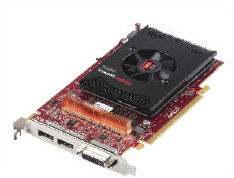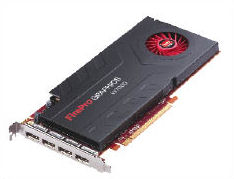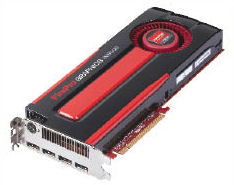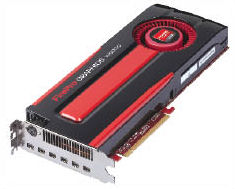AMD’s Latest FirePro Boards
A new GPU powers the FirePro W-series.
Latest News
December 4, 2001
While AMD has long been known as a competitor to Intel in the CPU market, the company moved into graphics in a big way in 2006 with its acquisition of ATI. In 2011, AMD sold more than 132 million discrete graphics cards. While most were Radeon boards aimed at the consumer market, more than 23% of revenue came from sales of professional graphics products. According to AMD managers we spoke with, the company is focusing on key vertical markets and expanded ISV support as the new FirePro boards become part of a stronger product mix.
Next GPU Technology: New Graphics Core
At the Sunnyvale event, AMD unveiled four new FirePro boards—the mid-range W5000, the high-end W7000 and W8000, and the ultra-high-end W9000. All four are based on the company’s fourth-generation Graphics Core Next (GCN) graphics processing unit (GPU), which features improved graphics performance, increased compute density (higher performance per square mm of board real estate), multi-tasking, and improved power efficiency. According to AMD, the new boards are optimized for heterogeneous computing and offer enhanced scalability. In previous generations of graphics boards, if you wanted to use the GPU for computing, you had to turn off the graphics until computations were completed—or use two graphics cards, one for computing and one for graphics. AMD’s GCN technology enables execution of a graphics thread and up to two compute threads per clock cycle at the same time on the GPU.
 The mid-range AMD FirePro W5000. |  The high-end AMD FirePro W7000. |
 The high-end AMD FirePro W8000. |  The ultra-high-end AMD FirePro W9000. Images courtesy of AMD. |
AMD has also implemented partially resident textures (virtual texturing), textures that have only portions of the texture stored in GPU memory at runtime. PowerTune technology monitors the boards’ power consumption to deliver faster GPU clock speed while remaining within thermal design limits. If an application is not making the most power available to the GPU, PowerTune can improve that application’s performance by raising the GPU’s clock speed by up to 30% automatically. And to reduce power consumption, AMD ZeroCore Power technology reduces idle power by up to 95% by shutting down the GPU when the system is idle.
All four of the new boards support PCI Express 3.0, whereas the previous generation only supported PCIe 2.1. The new FirePro W-series boards also allow a maximum DisplayPort 1.2 resolution of 4096x2160 at 60Hz (compared to 2560x1600 in the previous generation).
The New AMD FirePro W Family
For the mid-range, the AMD FirePro W5000 essentially replaces last year’s V5900. The new board carries a manufacturer’s suggested retail price (MSRP) of $599, the same as its predecessor. Its average street price of $450 also matches that of the V5900 when it was first released.
The board’s 2GB of GDDR5 memory and 256-bit interface also match that of its predecessor, but bandwidth improves to 102.4GB/second (from 65GB/s in the V5900). Based on a Pitcairn GL-PRO GPU with 768 stream processors and an 825MHz engine clock, AMD says that the W5000 can process up to 1.65 billion triangles per second. GeometryBoost allows the GPU to process geometry data at a rate of twice per clock cycle, resulting in a doubling in the rate of primitive and vertex processing.
Like its predecessor, the W5000 consumes a single slot and draws a maximum of 75 watts. And like the V5900 before it, the FirePro W5000 provides one dual-link DVI output and a pair of DisplayPort connections.
The W5000 supports CrossFire Pro, which enables users to harness the power of two GPUs by linking two identical FirePro cards together with the supplied connection cable. The board also comes with a DisplayPort-to-single-link-DVI adapter. But the new board also supports stereo 3D via an expansion bracket, a feature not found on the V5900.
At the high end, the AMD FirePro W7000 replaces last year’s FirePro V7900. But the new board’s MSRP of $899 is $100 less than its predecessor. With an average street price of $759, however, the W7000 costs essentially the same as the V7900 did when it was first released. The new Pitcairn GL-XT GPU has 1,280 stream processors and a 950MHz engine clock. It retains the same 256-bit interface as its predecessor, although the W7000’s memory bandwidth drops a bit, to 154GB/second. But the W7000 comes with 4GB of GDDR5 memory—double that of last year’s board.
The company claims floating point compute performance of 2.4 teraflops for single precision and 152 gigaflops for double precision. Power consumption of 150 watts matches that of the older board, so although the W7000 uses just a single PCIe X16 slot, a 6-pin auxiliary power connector is required.
Like its predecessor, the W7000 eschews DVI ports in favor of four DisplayPort connectors. You can use a DisplayPort-to-single-link-active-DVI connector should you want to attach an older monitor, and the W7000 comes with two of these adapters. And like the V7900, the W7000 supports stereo 3D via an additional bracket. The board also supports framelock/genlock via an optional FirePro S400 synchronization module—and also supports CrossFire Pro.
The new W8000 replaces the FirePro V8800 as AMD’s category leader for multitasking and application performance across up to four displays. With an MSRP of $1,599 ($1,325 average street price), the W8000 is $100 more expensive than its predecessor. That extra cost seems justified, however, considering the W8000 comes with 4GB of GDDR5 memory—double that of the previous board, and on the W8000 it’s error correcting code (ECC) memory. Both boards sport the same 256-bit interface, but the W8000 raises the memory bandwidth to 176GB/second.
The W8000 is based on AMD’s new Tahiti GL-PRO GPU, with 1,792 stream processors and a 900MHz engine clock. AMD claims floating point compute performance of 3.23 teraflops for single precision and 806 gigaflops for double precision.
Of course, the power requirements of the new board are also significant: 225 watts compared to 208 watts for its predecessor. Its two required 6-pin auxiliary power connections mean that the W8000 can only be installed in a workstation that can supply the necessary juice. The W8000 is also so thick that it covers the adjacent expansion slot. Like the V8800, the W8000 provides four DisplayPorts and a 3-pin Stereo 3D connector, and also accommodates the S400 synchronization module for framelock/genlock support. The W8000 also features two DisplayPort-to-DVI connectors and a CrossFire Pro connector.
At the ultra-high-end, the AMD FirePro W9000 comes with 6GB of ECC GDDR5 memory—compared to 4GB of non-ECC memory in the V9800 that it replaces—and an MSRP of $3,999. Based on the top-of-the-line Tahiti GL-XT GPU, with an incredible 2,048 stream processors and a 975MHz engine clock, the W9000 has a 384-bit memory interface and achieves a massive memory bandwidth of 264GB/second.
| SPECviewperf Benchmark Results for Current AMD FirePro Graphic Cards Reviewed | |||||||||||||||||||||||||||||||||||||||||||||||||||||||||||||||||||||||||||||||||||||||||||||||||||||||||||||||||||||||||||||||||||||||||||||||||||||||||||||||||||||||||||||||||||||||||||||||||||||||||||||||||||||||||||||||||||||||||||||||||||||||||||||||||||||||||||||||||||||||||||||||||||||||||||||||||||||||||||
| |||||||||||||||||||||||||||||||||||||||||||||||||||||||||||||||||||||||||||||||||||||||||||||||||||||||||||||||||||||||||||||||||||||||||||||||||||||||||||||||||||||||||||||||||||||||||||||||||||||||||||||||||||||||||||||||||||||||||||||||||||||||||||||||||||||||||||||||||||||||||||||||||||||||||||||||||||||||||||
AMD claims floating point compute performance of 4.0 teraflops single precision and 1.0 teraflops double precision. At 274 watts, however, its power consumption is also massive—approximately 50 watts higher than its predecessor. To support this board, you’ll need both a 6-pin and an 8-pin auxiliary power cable, and the extra-thick W9000 covers the adjacent expansion slot.
As one would expect, the W9000 has a 3-pin mini-DIN for stereo 3D, and offers optional framelock/genlock support, but while both the V9800 and W9000 support up to six displays, the ports on the new W9000 are mini DisplayPorts. The W9000 comes with two mini-DisplayPort-to-single-link-DVI adapters and a CrossFire Pro connector.
Benchmarking the Boards
We tested the new AMD FirePro W5000, W7000, W8000 and W9000 boards in an HP Z820 workstation equipped with a pair of Intel Xeon E5-2687W 3.1GHz eight-core CPUs and 32GB of memory, running the 64-bit version of Windows 7. That system supports PCIe 3.0, and its 1125-watt power supply has more than enough capacity to meet the demands of the ultra-high-end boards, although we needed a special 6-to-8-pin power adapter to handle the W9000.
We ran version 11 of the SPECviewperf video benchmark. We also retested the previous generation FirePro V-series boards in the HP Z820, using the latest FirePro video driver.
Based on our results, the newest AMD FirePro boards surpass the performance of the older boards, with the new mid-range W5000 actually outpacing the older, high-end V7900 and the new W7000 outperforming the V8800. Because we didn’t test the V9800, we were not able to make any comparisons to that board.
We also tested several new- and previous-generation NVIDIA graphics boards in the same HP Z820 workstation, so that we could see how AMD stacks up against its competition (see page 44 for a quick price/performance comparison).
While we certainly saw improvements from one generation to the next, the differences on the SPECviewperf benchmark were simply not as great as we had expected, particularly for the W9000. Remember, however, that benchmarks are synthetic tests that don’t necessarily reflect real-world performance. We suspect that the benchmarks simply never really pushed the W9000 board to where its 6GB of memory and 2,048 processors would show off its true power.
Considering its price, this board is not for everyone. But if you work with very large models or run GPU-based computations, the W9000 is worth considering.
The new AMD FirePro boards are fully certified with most CAD and DCC applications, and all of the boards in the FirePro line use the same unified video driver. Drivers are available for most 32- and 64-bit operating systems, including Windows 8, Windows 7, Windows Vista, Windows XP, and Linux. All of the new AMD FirePro boards carry a three-year limited product repair/replacement warranty, and direct toll-free phone and email tech support.
AMD continues to sell the previous-generation FirePro V-series boards, so customers have choices at every price point. With AMD’s increased focus on the pro workstation market, competition with rival NVIDIA is clearing heating up.
David Cohn is the technical publishing manager at 4D Technologies. He also does consulting and technical writing from his home in Bellingham, WA, and has been benchmarking PCs since 1984. He’s a contributing editor to Desktop Engineering and the author of more than a dozen books. You can contact him via email at [email protected] or visit his website at DSCohn.com.
MORE INFO
- AMD Fire Pro W9000 MSRP: $3,999 Avg. Street Price: $3,400
- AMD Fire Pro W8000 MSRP: $1,599 Avg. Street Price: $1,325
- AMD Fire Pro W7000 MSRP: $999 Avg. Street Price: $759
- AMD Fire Pro V5000 MSRP: $599 Avg. Street Price: $450
Subscribe to our FREE magazine, FREE email newsletters or both!
Latest News
About the Author
David Cohn is a consultant and technical writer based in Bellingham, WA, and has been benchmarking PCs since 1984. He is a Contributing Editor to Digital Engineering, the former senior content manager at 4D Technologies, and the author of more than a dozen books. Email at [email protected] or visit his website at www.dscohn.com.
Follow DE




